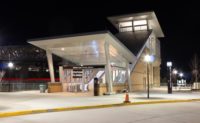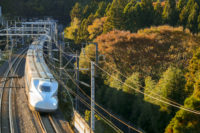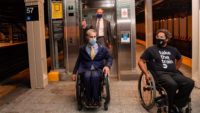Washington, D.C.’s Union Station is a step closer to a long-needed comprehensive makeover, with the Federal Railroad Administration issuing the final environmental impact statement and record of decision on a plan to upgrade the facility’s rail infrastructure and improve operations while also preserving the historic station building.
Currently estimated to cost $8.8 billion and unfold over 13 years, the preferred alternative calls for a new modernize train hall and concourse featuring soaring ceilings and a vertical glazed wall providing a full view of track activity. The station’s existing railyard will be replaced with 12 stub-end tracks on the west side and seven run-through tracks on the east side.
Other elements of the 53-acre program include incorporating a new integrated intercity bus terminal above the train hall, an underground garage and pick-up/drop-off area and improved connectivity with the train hall, with concourses providing improved interior circulation and various services and amenities to passengers and visitors.
The non-profit Union Station Redevelopment Corporation (USRC) is designated as the project sponsor, and will be responsible for implementing the project through final design and construction, in coordination with Amtrak.
Originally constructed in 1908, Union Station serves as a major transportation hub for the metropolitan Washington area, serving more than 100,000 passengers annually with Amtrak, Maryland and Virginia commuter rail systems, Metrorail and Greyhound bus service. An extensive $180-million renovation effort completed in September 1988 restored and rehabilitated the building, along with adding a new retail area, food court and movie theater. A five-year $20-million renovation of the space completed in 2016 to upgrade structural and building systems, and repaired damage from a 2011 earthquake.
These efforts were not enough to arrest a gradual decline in the retail area’s fortunes, a trend exacerbated by the COVID-19 pandemic. Meanwhile, the existing train concourse has long been insufficient to accommodate growing passenger demand.
The redevelopment plan aims to support current and future long-term growth in rail service by improving capacity, reliability, safety, efficiency, accessibility and security, with the historic station building continuing to serve as the facility’s “monumental” focal point.
To balance operational needs with the redevelopment program’s schedule, the preferred alternative envisions a four-phase construction process, during which a set number of tracks and platforms are taken out of service and turned into an active construction zone, with cut-off and support walls installed to support excavation and prevent groundwater infiltration. Following excavation, drilled shafts will provide deep foundations for the slabs supporting the new tracks and the columns supporting the deck on which project elements would stand. As construction moves to the next phase, deck-level project elements would be constructed.
The effort poses numerous technical challenges as well. For example, installation of new tracks and associated platforms will require removing more than half of the station’s existing 28 building-support columns. According to the preferred alternative, this work will likely involve installation of temporary shoring towers and foundations, demolition of the existing retail and ticketing concourse floor, and replacing a portion of an underlying rail tunnel’s existing east wall. Numerous existing utilities will also have to be relocated as well.
With the FRA’s environmental impact statement process complete, USRC can now move the redevelopment project into the design phase and develop a funding plan to carry the project through to construction, with full operation currently envisioned for 2040.





Post a comment to this article
Report Abusive Comment